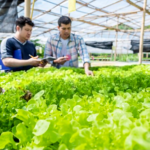Rockwool, which is also known as mineral wool or stone wool, is the most popular medium used by hydroponic users nowadays. The main purpose of using this substrate is to achieve maximum like commercial production. The demand for this medium is growing rapidly therefore in this article, I am going to have a brief discussion on how to use Rockwool in hydroponics.
The benefits of using Rockwool are so many. As it retains moisture and oxygen, there is less chance of under-watering and overwatering. Moreover, the roots will never face any prevention or blockage. With all these advantages, the Rockwool growing medium(Internal) is perfect for both beginners and expert users.
For a proper answer of how to use hydroponic Rockwool, I have paid attention to discuss its maintenance also. Hopefully, this article will help you with growing vegetables such as growing basil, tomatoes in Rockwool.
Setting up Rockwool in Hydroponics
Propagation cubes, large slabs, and even granulated products are the range of sizes that a Rockwool can grow in. Its manufacturing depends on melting basaltic rock and later spinning this molten mix into thin fibers. At last, air is been used to cool down the thin fibers.
This man-made product is basically made of rock. Grodan is the most popular one but you can go for any Rockwool. The setting up process is easy and simple, though you have to go through step by step process.
1. Sit the Rockwool Down: Growing slabs, large cubes, pots, and a few more kinds of Rockwool are available. Whatever the kind you are using, the basic preparation is very vital for all.
If you are going with slabs and cubes then there is always a chance of developing moisture. As a solution, you have to make the surface flat and even so that the indentations force the material to sink and create gaps. There is always a chance of draining the nutrient solution in the slab’s plastic wrapper from the hole’s cut. For this, you have to consider the drainage of the solution.
If you do not take care of this then there might be a nutrition loss at any time. In the market, you will find many hydroponic systems with Rockwool that are designed with treys or channel for the drainage waste.
2. Settling the Rockwool: We have already known the possible mediums of Rockwool. Whatever the type you have chosen, the substrate must be properly wet before using them. The method of adjusting the pH of the water to 5.5 before wetting the Rockwool is very common. But it is not mandatory if your system is small or you are using a good brand.
Before letting to drain, all the material must be wet. For this, you have to saturate the Rockwool properly. For making sure a good drenching you can also water into the Rockwool slab. Another option is to pour water on or run the irrigation process for a longer period.
3. The Holes: So far, we explain how to water Rockwool cubes. After watering, it comes to the drainage which is also important. The water that remains in the system must go out through the cut holes. You can also create some holes in the base of the slabs. Before placing Rockwool into containers or pots, checking the diameter of the holes is mandatory.
4. Irrigation: The use of drippers in the Rockwool is very effective. It is been used for applying nutrients in the system. You have to set one dripper for each plant and it should hold the capacity of 2 liters per hour. Going with this rate will be perfect for the seeds in Rockwool hydroponics.
Usually, a Rockwool system can contain multiple plants. So, you have to set drippers according to plant numbers. If one dripper gets clogged, it will not hamper the irrigation as other drippers will continue the process smoothly.
Use of Rockwool Cubes
 When it comes to the Rockwool cubes, you may ask how to use Rockwool grow cubes. According to their sizes, the Rockwool cubes can hold a good amount of water. It is helpful as this extra water can work if there is any emergency case like pump or timer downs because of power outages.
When it comes to the Rockwool cubes, you may ask how to use Rockwool grow cubes. According to their sizes, the Rockwool cubes can hold a good amount of water. It is helpful as this extra water can work if there is any emergency case like pump or timer downs because of power outages.
Oxygen supply to the root zone is also important and the Rockwool cubes hold almost 18% oxygen. It makes sure that there is no over-watering to the plants. As a growing media, these cubes can act as an effective assistant. It germinates seeds and propagates new cuttings.
To operate these two functions, the 1.5” cubes are mostly used. For small plants, there are large cubes that can be used as a growing medium. Here the size of the cubes will be up to 4”. You are allowed to use the large cubes but not on a greater scale.
What Can Be Grown in Rockwool?
In your Rockwool hydroponic system, you can grow different kinds of vegetables such as tomatoes, peppers, basil, leafy greens, and cucumbers. All these are the ideal ones to go with in your Rockwool system. Growing tomatoes in Rockwool is not a wise pick for the beginners. For commercial and dedicated growers, this vegetable can be a good option.
For growing basil in Rockwool, you have to germinate the seeds first. You can carry these plants in between 3 to 10 days after germinating. Cultivating basil is easy to start but to get expected results, taking proper care is necessary.
For any plant, growing seeds in Rockwool is the first step to complete. After doing this the rest will become easy for you. Besides vegetables, flowers can also be grown in Rockwool.
Final Verdict
For growing in hydroponics, the Rockwool is a fundamental way to go. Usually, basaltic rock and chalk are been used to make the Rockwool cubes that give it strength. The popularity of this system lies behind the good rate of retaining moisture and oxygen. Moreover, there will be no case of blocking the development of roots.
You will never regret it if you buy Rockwool for hydroponics. Depending on the condition, you can take any of your choices. There are several sizes and shapes available so that you can pick one that suits your need best. With Rockwool, you will obtain better and profitable results from your hydroponic system.




